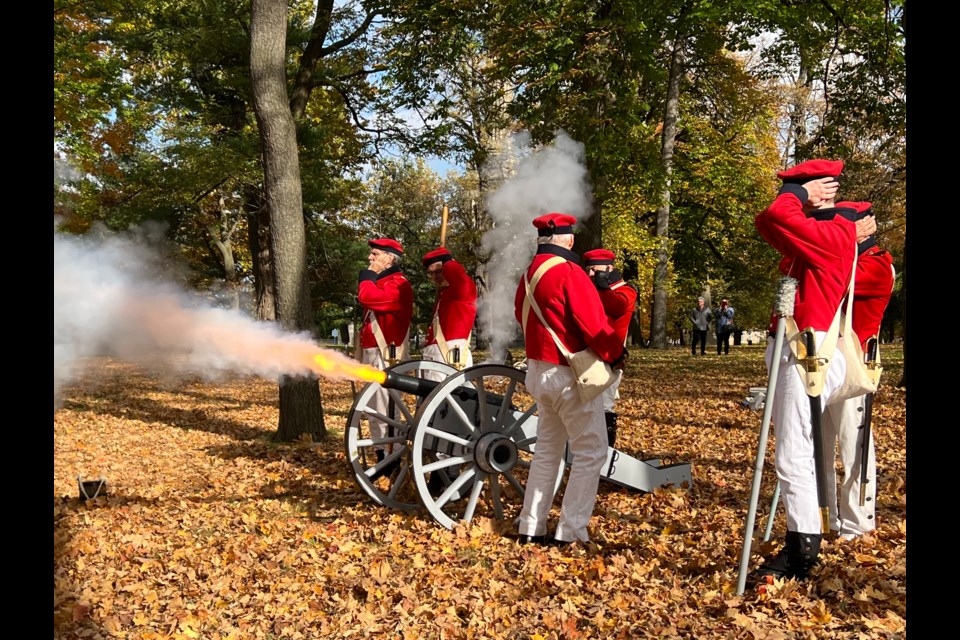Amidst the orange and yellow leaves of fall, the stark red and white uniforms of the 2nd Lincoln Artillery complemented the day as the artillery broke a moment of silence with cannon fire to honour Indigenous veterans at the Landscape of Nations in Queenston Heights Saturday.
It was the seventh anniversary of the unveiling of this landmark.
The smell of burning sage, and smoke from a Ceremonial Fire tended by Brian Kon, set the scene of remembrance and gratitude during the ceremony.
Travis Hill, curator of Indigenous culture and heritage with the city of Hamilton, emceed the event. “We have a day representing Indigenous warriors past and present,” he said.
Karl Dockstader, Niagara College’s Indigenous education cultural consultant, began the Valour and Victory program with a traditional greeting “in the language of people who lived here hundreds of years ago.” He translated his greeting as “our minds are one,” referring to social justice, Dockstader explained, “where we have a responsibility as people, together, to make things happen,” such as honouring Indigenous veterans.
Flanked by statues of John Norton (Teyoninhokarawen) and Joseph Brant (Ahyouwa’ehs), David Adames, chief executive officer of Niagara Parks, welcomed the large crowd of people.
“As contemporary environmental and cultural stewards of this land, we are grateful for the stewardship provided by Indigenous peoples for millennia,” he said.
“Niagara Parks takes great pride in collaborating with Indigenous leaders to celebrate and share the rich history of these lands. Public initiatives, such as the Landscape of Nations and the Valour and Victory ceremony today, help to affirm the proper place of Indigenous peoples, not only at the centre of the stories we tell here in Niagara, but within Canada’s historical narrative,” said Adames.
He also commented on the significance of the number seven in Haudenosaunee culture, and pointed out that the Landscape of Nations reflects this with seven steel arches symbolizing a longhouse, and seven earthen mounds representing nature and signifying the Indigenous nations involved in the Battle of Queenston Heights and the War of 1812.
Tim Johnson, senior advisor for Heritage and Legacy at the Niagara Parks Commission, announced the launch of a Landscape of Nations social media page. “We will be moving forward with the intention of providing the best historical content and factual news information and perspectives on Indigenous events and issues of the day,” he said.
Follow the Landscape of Nations page on Facebook to learn more.
Paul Williams, historian and Six Nations lawyer, spoke about the significant contributions of John Norton, Mohawk Chief and leader of First Nations allies in Upper Canada, who played a crucial role in several major battles during the War of 1812.
“When Brock fell and the British troops with him retreated, those 80 men (under Norton’s command) pinned down 1,300 Americans for two hours until British reinforcements arrived,” said Williams.
Indigenous veteran and service members Jessica Miller and Cita Johnson were recognized for their service.
Retired Warrant Officer Miller, from the Six Nations and Mohawk Nation, started her 25-year military career as a naval communicator in the Canadian Armed Forces in 1999. She completed the ordinary seamen under training program on board the HMCS Algonquin, and during her posting, visited many ports throughout the world.
Cita Johnson, Onondaga from Six Nations, completed her basic training in the Black Bear Program, which combines Indigenous and military teaching. She is an officer in the 56th Field Artillery and is now helping run courses and is a troop leader. She fondly remembers her grandfather taking her to play at Queenston Heights Park.
An Honour Song, performed by long-standing cultural community member Phil Davis, and accompanied by Karl Dockstader, preceded the Moment of Silence and Laying of Wreaths.



